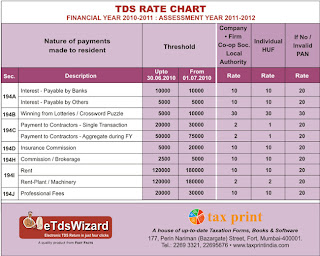The Finance Ministry has initiated the e-TDS since year 2003. When the paper work became huge at corporate level, the instances of typo-errors started increasing thus making it difficult to check and balance the TDS deducted and paid to the Government. The TDS software helps in filing the eTDS returns to both corporate and non-corporate Tax payers and tax deductors.
The responsibility of remitting the taxes deducted to the Government lies on the person who deducts the tax at source. The prescribed time is within 7 days’ from the end of the month for which the tax is deducted.
The Income tax laws identify two types of assessees who can deduct Tax:
- 1) Corporate assessees
- 2) Non Corporate Assessees
- 3) Individuals and Partnership firms that are subject to Tax Audit under Section 44AB of the Income tax Act, 1961.
- Separate challan should be used for the above type of deductees.
a) Any person who makes payment to other, which exceeds Rs 20,000/- per year should deduct Tax at source.
b) In case of interest payment, if the amount exceeds Rs 10,000/- per annum, the Tax has to be deducted at source from such interest payment.
c) Company or firm that makes payment to contractors or suppliers should deduct TDS from the gross payment and pass on the net amount to the concerned.
d) Partnership firms/ individuals who do not fall within the purview of tax audit (i.e. gross income does not exceed Rs 40 Lakhs per annum) are not required to deduct tax at source.
e) Again, those firms or individuals who are subject to Tax audit under Section 190 of the Income Tax Act, 1961 have to deduct Tax at source and remit the money to Government Treasury.
Rule 30 lays down the due dates for remittance of TDS amount into the Government treasury:
- 1. In case of Government – the same day on which Tax was deducted.
- 2. In case of Non Government: within 7 days from the month ending in which tax was so deducted.
- 3. In case of tax that was deducted as provision for payments to be done, then the amount should be deducted within 60 days from the end of the financial year to which such provision applies.
- If there is any delay in remitting the amount, the assessee will be liable for penalty by way of interest on the TDS amount payable to the Government, which is normally @ 1%. Timely filing of TDS returns will save the penalty.







